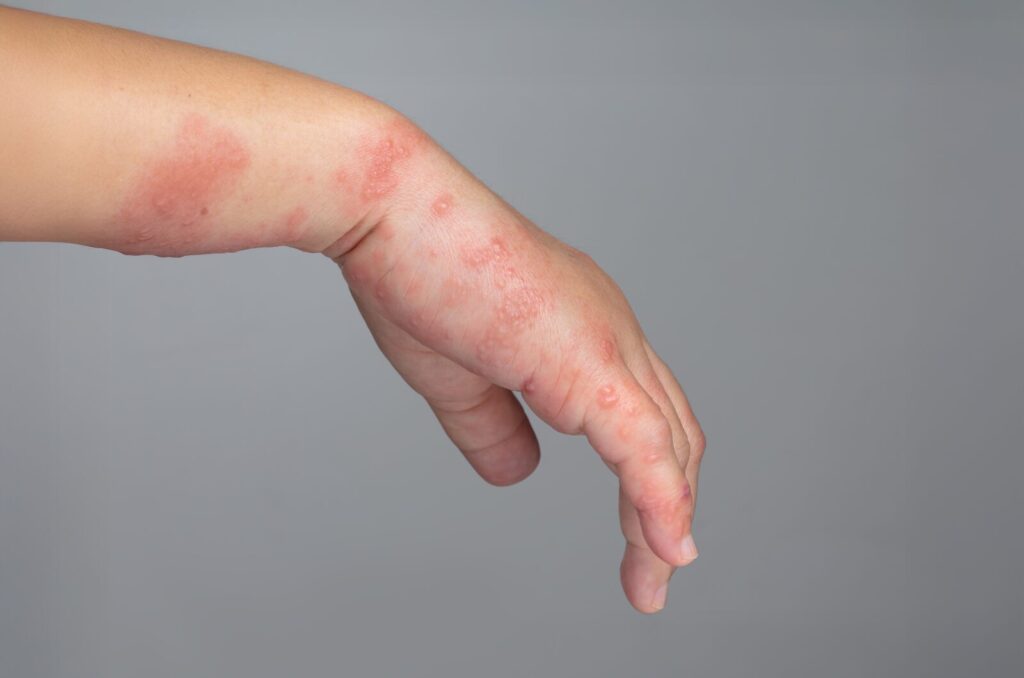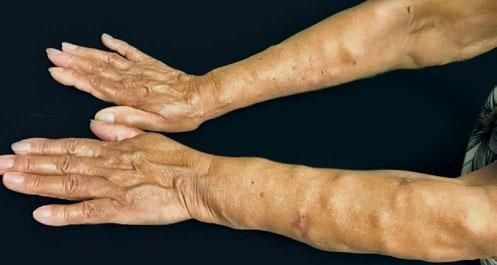Dercum’s disease is characterized by painful fatty growths called lipomas that appear under the skin. The exact causes of Dercum’s disease remain unclear but usually involve neurologic and endocrine system dysfunction, as well as possible genetic and inflammatory factors. These underlying causes contribute to painful fatty masses, affecting the limbs and trunk.
People with dercum’s disease symptoms notice chronic pain, fatigue, swelling, and cognitive difficulties that interfere with daily activities. The condition gradually worsens, causing significant discomfort and reduced mobility. Recognizing these early signs is essential to seek timely treatment for Dercum’s disease, which can improve symptoms and quality of life.
This article will explore the common symptoms, causes, and treatment options available to California residents, providing valuable insights for those affected or concerned about this challenging condition.
What are the Symptoms of Dercum’s Disease among Californians
The symptoms of Dercum’s disease include common painful fatty growths (lipomas), fatigue, swelling, cognitive effects, and varying degrees of chronic pain. These Dercum’s disease symptoms affect patients differently but lead to considerable discomfort and a decline in quality of life.
Common Painful Fatty Growths (Lipomas) and Their Physical Impact
A hallmark of Dercum’s disease symptoms is the presence of multiple painful fatty lumps or lipomas, which develop under the skin. These lipomas vary in size and are usually tender or painful when touched. Located mainly on the limbs and trunk, these growths restrict movement and cause pressure on surrounding tissues, nerves, and blood vessels.
The physical impact of these lipomas leads to stiffness and difficulty in performing everyday activities. Early identification of these symptoms is crucial for California residents, as pain management and treatment strategies depend heavily on the extent and severity of these fatty deposits.
Associated Symptoms Including Fatigue, Swelling, and Cognitive Effects
Beyond painful lipomas, other dercum’s disease symptoms include persistent fatigue, swelling in affected areas, and cognitive challenges such as difficulty concentrating or “brain fog.” Fatigue is debilitating and reduces patients’ ability to maintain regular routines. Swelling accompanies lipomas due to inflammation, making limbs feel heavy and uncomfortable.
Cognitive effects interfere with memory and mental clarity, compounding the overall burden of the disease. These symptoms affect daily functioning and emotional well-being, underscoring the complex nature of managing Dercum’s disease.
How Symptoms Vary from Mild Discomfort to Severe Chronic Pain
Dercum’s disease symptoms range from mild discomfort to intense, chronic pain. Some individuals may notice slight tenderness or sensitivity around fatty growths in early stages. However, many progress to severe pain that is persistent and difficult to control, significantly impairing mobility and quality of life.
This chronic pain can be sharp, aching, or burning and may worsen with physical activity or pressure. The variable nature of symptoms makes personalized treatment essential. Recognizing the spectrum of these symptoms allows patients and specialists to tailor therapies effectively for symptom relief and improved daily function.
Understand the Causes and Potential Triggers of Dercum’s Disease

Suggested image alt: Hand with red patches and raised bumps, possibly linked to Dercum’s disease, causing painful fatty growths.
Dercum’s disease causes and triggers include neurologic and endocrine factors, genetics, inflammatory and mechanical causes, and risk factors relevant to California residents and the general population.
Neurologic and Endocrine Factors Underlying the Disorder
Dercum’s disease involves neurologic dysfunction affecting pain perception and endocrine imbalances related to hormones like insulin and cortisol. These factors may disrupt fat metabolism and promote inflammation, leading to painful lipoma formation.
Struggling with swelling, fatigue, or post-surgery recovery?
Book your personalized lymphatic drainage session today and experience natural, therapeutic healing that restores balance and promotes long-term wellness.
Book an AppointmentStudies on Dercum’s disease show altered levels of neuropeptides such as substance P in patients, suggesting nerve involvement in pain symptoms. Hormonal imbalances may contribute to abnormal fat storage and swelling. Understanding these neurologic and endocrine roles is vital to developing effective treatment for dercum’s disease targeting symptom relief.
Theories on Genetic, Inflammatory, and Mechanical Causes
Genetic predisposition may play a role, as some family clusters have been reported. Chronic inflammation is thought to intensify fat tissue pain and growth. Mechanical trauma or repeated pressure may trigger lipoma formation or worsen symptoms by damaging tissues.
Research shows interplay between genetics, inflammation, and mechanical factors contributes to dercum’s disease progression. Continued research focuses on these areas to better understand patient variability and refine treatment approaches.
Risk Factors Specific to California Residents or the General Population
Common risk factors include obesity, female sex, and middle age, consistent across populations, including California residents. Studies on rare diseases reveal that environmental factors such as lifestyle, diet, or exposure to pollutants in California may influence disease expression but require further study.
Awareness and healthcare access also affect diagnosis rates regionally. Recognizing these factors helps guide early screening and management to improve outcomes in diverse communities.
Current Treatment Options Available for Dercum’s Disease in California
The current treatment options available for Dercum’s disease are pain management strategies, manual lymphatic drainage, complementary treatments, surgical interventions, and lifestyle modifications for symptom relief. Understanding the causes of Dercum’s disease is critical to developing an effective treatment for Dercum’s disease that addresses these challenging symptoms.
Pain Management Strategies Including Medications and Therapies
Pain management is crucial in the management of Dercum’s disease. Medications such as pregabalin, lidocaine, and nonsteroidal anti-inflammatory drugs help reduce nerve pain, a common dercum’s disease symptom. Other therapies like acupuncture assist in managing chronic pain, focusing on improving patient comfort and functionality.
Use of Manual Lymphatic Drainage and Other Complementary Treatments
Manual lymphatic drainage (MLD) stimulates lymph flow and reduces swelling often experienced as part of Dercum’s disease symptoms. Complementary options, such as pneumatic compression and transcutaneous electrical nerve stimulation, work alongside MLD to ease pain and inflammation. Together, these therapies offer holistic treatment for Dercum’s disease.
Surgical Interventions and Lifestyle Modifications for Symptom Relief
Surgical options such as liposuction and lipoma excision remove painful fatty growths related to dercum’s disease causes and provide symptom relief. Though surgery doesn’t cure the disease, it alleviates discomfort and improves mobility.
Lifestyle modifications, including a healthy diet, maintaining an ideal weight, and regular low-impact exercise, can support treatment for Dercum’s disease by reducing symptoms and enhancing overall health.
Conclusion
Dercum’s disease symptoms negatively affect your daily life. However, understanding Dercum’s disease causes opens the door to effective treatment for dercum’s disease tailored to your needs. Early diagnosis and personalized care help you regain control over pain and discomfort. Do not wait to take action. Schedule your consultation today with a specialist experienced in Dercum’s disease and start your journey toward better health.
FAQ’s
What are common dercum’s disease symptoms?
The symptoms of Dercum’s disease include painful fatty growths called lipomas, fatigue, swelling, cognitive difficulties, and chronic pain. These symptoms vary widely between patients. Early recognition of Dercum’s disease symptoms is crucial for seeking timely treatment for Dercum’s disease and preventing further progression.
What causes Dercum’s disease?
Dercum’s disease causes involve neurologic dysfunction, endocrine imbalances, genetic factors, inflammation, and mechanical triggers. These causes lead to painful fatty growths under the skin. Understanding Dercum’s disease helps healthcare providers create personalized treatment plans for better symptom management.
What treatment for Dercum’s disease is available?
Treatment for Dercum’s disease focuses on pain management, manual lymphatic drainage, complementary therapies, surgical removal of lipomas, and lifestyle modifications. These options aim to control Dercum’s disease symptoms, improve mobility, and enhance patient quality of life, although there is currently no cure.
Is Dercum’s disease hereditary or contagious?
Dercum’s disease is not contagious. Some cases may have a hereditary component, but most appear sporadically. Though Dercum’s disease causes include genetic factors, it does not spread person to person. Knowledge of Dercum’s disease causes guides genetic counseling and treatment planning where relevant.
Can lifestyle changes improve Dercum’s disease symptoms?
Yes, lifestyle changes improve Dercum’s disease symptoms. Lifestyle modifications such as healthy eating, weight control, and regular low-impact exercise support treatment for Dercum’s disease.
These changes reduce the severity of dercum’s disease symptoms, improve mobility, and enhance overall well-being when combined with medical therapies and pain management strategies.

